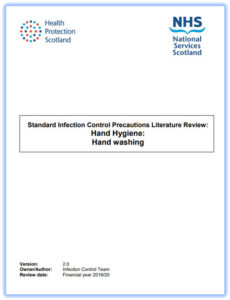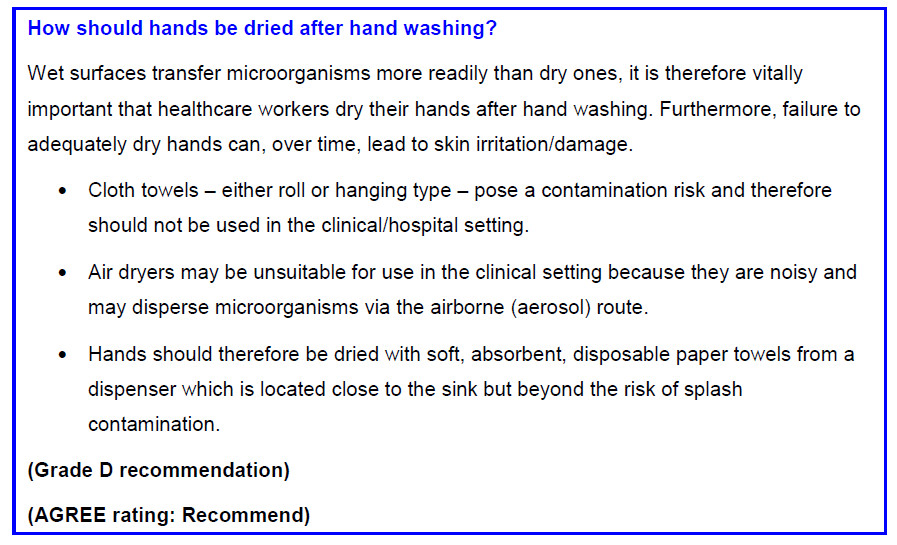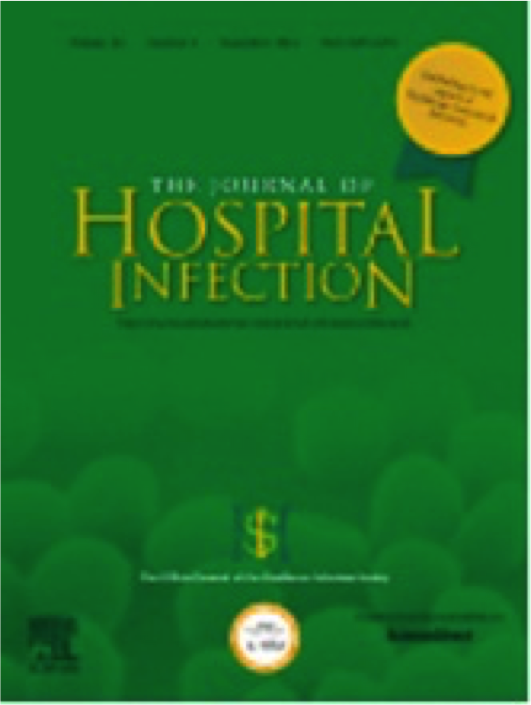Hand washing Infection Control Precautions document by NHS (National Services Scotland) concludes that air dryers are NOT recommended in the clinical setting.
It is recommended that soft, absorbent, disposable paper towels are used across NHS Scotland for hand drying following hand washing in the healthcare environment.
New guidance on hand hygiene: hand washing, published by the National Services Scotland (NHS), indicates that the use of electric hand dryers as a method of hand drying in is NOT recommended in the clinical setting, because a degree of risk has been identified relating to their use.
Based on the identified evidence, it is recommended that soft, absorbent, disposable paper towels are used across NHSScotland for hand drying following hand washing in the healthcare environment.
Issued by Health Protection Scotland / NHS National Services Scotland, the document: “Standard Infection Control Precautions Literature Review: Hand Hygiene: Hand washing” reviews the professional literature regarding the correct technique for hand washing for standard infection control purposes.
 A number of parameters were assessed, including:
A number of parameters were assessed, including:
* What is the recommended water temperature for hand washing?
* How should hands be washed?
* What is the correct technique to ensure that all surfaces of the hands are covered during washing?
* How should hands be dried after hand washing?
etc.
On the subject of hand drying, the report quotes a number of studies and among them those undertaken by Professor Mark Wilcox MD, consultant microbiologist, Leeds Teaching Hospitals and University of Leeds, UK, and Keith Redway of the University of Westminster.
These studies found that electric dryers contaminate both the air and the surfaces in washrooms with bacteria and viruses. (see 1-2 below)
This is the recomendation provided by Health Protection Scotland / NHS National Services Scotland:

The entire document: “Standard Infection Control Precautions Literature Review: Hand Hygiene: Hand washing” can be downloaded here: NHS Scotland Precautions
1. Microbiological comparison of hand drying methods: the potential for contamination of the environment, user and bystander. E.L. Best,1 P. Parnell,1 M.H. Wilcox 1,2 – Microbiology Department, Old Medical School, Leeds General Infirmary, Leeds Teaching Hospitals NHS Trust1 & University of Leeds,2 Leeds LS1 3EX, UK. Journal Hospital Infection 2014; 88:199-206. See also the page: Microbiological comparison of hand drying methods …
2. “Comparison of different hand-drying methods: the potential for airborne microbe dispersal and contamination” and is authored by Keith Redway (Department of Biomedical Sciences, Faculty of Science and Technology, University of Westminster, London, UK) and by E.L. Best (Microbiology Department, Old Medical School, Leeds General Infirmary, Leeds Teaching Hospitals NHS Trust, Leeds UK). Journal Hospital Infection 2015;89:215-217. See also the page: Comparison of different Hand drying methods














